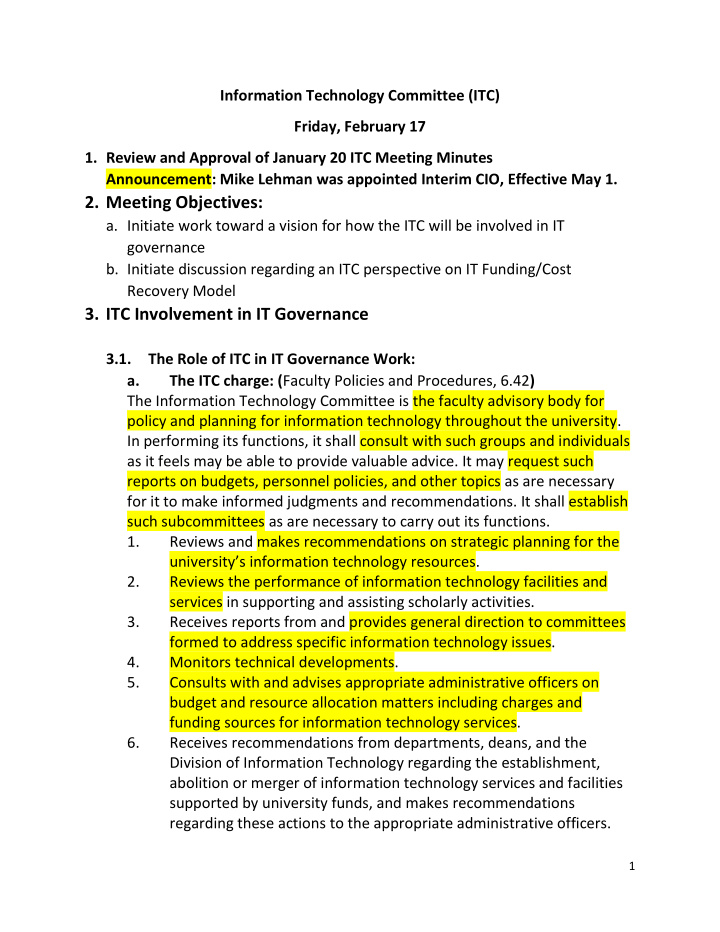



Information Technology Committee (ITC) Friday, February 17 1. Review and Approval of January 20 ITC Meeting Minutes Announcement: Mike Lehman was appointed Interim CIO, Effective May 1. 2. Meeting Objectives: a. Initiate work toward a vision for how the ITC will be involved in IT governance b. Initiate discussion regarding an ITC perspective on IT Funding/Cost Recovery Model 3. ITC Involvement in IT Governance 3.1. The Role of ITC in IT Governance Work: a. The ITC charge: ( Faculty Policies and Procedures, 6.42 ) The Information Technology Committee is the faculty advisory body for policy and planning for information technology throughout the university. In performing its functions, it shall consult with such groups and individuals as it feels may be able to provide valuable advice. It may request such reports on budgets, personnel policies, and other topics as are necessary for it to make informed judgments and recommendations. It shall establish such subcommittees as are necessary to carry out its functions. 1. Reviews and makes recommendations on strategic planning for the university’s information technology resources. 2. Reviews the performance of information technology facilities and services in supporting and assisting scholarly activities. 3. Receives reports from and provides general direction to committees formed to address specific information technology issues. 4. Monitors technical developments. 5. Consults with and advises appropriate administrative officers on budget and resource allocation matters including charges and funding sources for information technology services. 6. Receives recommendations from departments, deans, and the Division of Information Technology regarding the establishment, abolition or merger of information technology services and facilities supported by university funds, and makes recommendations regarding these actions to the appropriate administrative officers. 1
b. ITC Relationships to IT Governance Groups: Relationships to the Steering Committee and Advisory Groups: • The ITC and the IT Steering Committee (ITSC) share the responsibilities of strategic IT planning, strategic IT investments and initiatives; reviewing the performance of IT investments, facilities, and services; making necessary changes; and monitoring improvements. • The ITC is responsible for establishing/endorsing policies that require shared-governance resolution. • The ITC and the ITSC work with IT Advisory Groups in the process of establishing policies and making decisions. • The ITC and the ITSC may assign key projects, tasks or actions to specific Advisory Group(s) in order to advance strategic initiatives in a collaborative and transparent manner. 2
c. On-Going Strategic Initiatives and Goals: 1. Service inventory study. 2. IT spend FY16. 3. Recruitment of two administrative positions: Director, IT Center of Excellence Cloud Strategist/Architect Both positions will report to the campus CIO. 4. Project intake and prioritization process 5. Analysis of service inventory data (after collecting inventory data). 6. New business model: Cost-recovery/funding model. 7. Cybersecurity risk management policy. Director, IT Center of Excellence position: • Assists the campus IT leadership in developing the overall service vision and strategy that focuses on aligning IT services with the core mission and needs of the University. • Defining IT services from business-centric, outcome- and value- focused perspectives that are meaningful to business, administrative and academic stakeholders. Cloud Strategist/Architect position: • Lead cultural and organizational change for cloud adoption. • Develop and coordinate cloud architecture. • Develop a cloud strategy and coordinate adoption. 3
Major Goals: • Focus on service. • A focus on services requires an examination of the value those services provide and allows closer alignment with institutional strategy and goals in an effort to increase that value. • The increasing availability and adoption of cloud technologies and services is one of the drivers of the shift toward a service-centric focus. Cloud services and technologies offer opportunities for value- adding features such as scalability, flexibility, reliability, and uptime that are hard to provide on premises. • Increased effectiveness and efficiencies; greater service consolidation, greater adoption of centrally provided services. • Strategic prioritization of IT services. c. Vision for ITC Role and Work: Discussion: Dee Warmath, Steve Hahn, Steve Cramer 4
3.2. How Might we enact the ITC Role? a. Possible Models for the ITC Work: Model 1: The ITC creates its own sub-groups to develop guidelines/recommendations on key projects, tasks, or actions. Example : A sub-group to study funding model. Model 2: The ITC participates in establishing guidelines for the work of other working groups. Example : Guidelines for the working group on Student Information Services. Model 3: ITC members participate in the work of other sub-groups. Example : Part of the cross-TAG working group that will work on planning the process for analyzing the inventory data. b. Work Organization: • Introduce and discuss a topic in a given month. • Following month: Decisions/resolutions. c. Small Group Discussion: Dee Warmath; Steve Hahn 5
4. Topic Introduction: IT Funding/Cost Recovery Model Will be discussed in March meeting. Observations: Cost recovery for IT services provided by DoIT is mandated by campus policy. This funding model has been in place for over 20 years. Cost recovery includes the following components: a. Fees for IT services provided by DoIT to campus units. b. Chargeback assessments to campus units, including campus IT licenses and shared campus IT systems; Common System Operations; Network Services. The methodology for calculating cost-recovery fees for DoIT services is designed to recover direct costs as well as indirect (overhead) costs. Discussion questions for March meeting: Is the current cost-recovery model an effective mechanism for (a) prioritizing IT services across campus, and (b) allocating scarce IT resources effectively? In particular: • Is it aligned with the mission and objectives of the university as a whole? • Does it provide the right incentives for promoting decisions on the part “customers” (campus units) and providers (DoIT units) that are effective and optimal from the point of view of the campus as a whole? • What are the incentives/disincentives for using/adopting centralized IT services? • Do these vary by college/department or area (research, teaching & learning)? 6
Recommend
More recommend